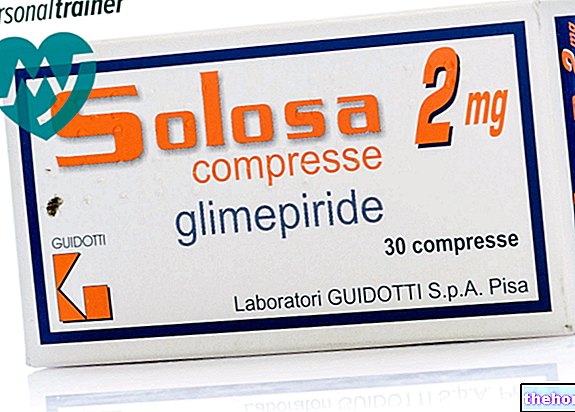Active ingredients: Oxitropium bromide
Oxivent 1.5 mg / ml nebuliser solution
Indications Why is Oxivent used? What is it for?
Oxivent contains oxitropium bromide, which belongs to a group of medicines called bronchodilators, which help clear the airways so you can breathe more easily.
Oxivent is indicated for the treatment of respiratory tract diseases in adults such as:
- bronchial asthma
- chronic obstructive pulmonary disease (chronic lung disease characterized by bronchial obstruction) with asthmatic component.
Talk to your doctor if you don't feel better or if you feel worse.
Contraindications When Oxivent should not be used
Do not use Oxivent
- If you are allergic to oxitropium bromide or any of the other ingredients of this medicine (listed in section 6)
- If you are allergic to atropine (a substance that acts in the nervous system) and its derivatives (substances similar to atropine)
- If you suffer from closed-angle glaucoma (severe form of glaucoma, which is a disease of the eye caused by an increase in the pressure of the fluid contained within the eye)
- If you suffer from prostatic hypertrophy (enlargement of the prostate)
- If you have urinary retention (inability of the urinary bladder to empty completely)
- If you suffer from intestinal obstruction (intestinal obstruction)
- If you are under the age of 18
- If you are pregnant or breast-feeding (see "Pregnancy, breast-feeding and fertility").
Precautions for use What you need to know before taking Oxivent
Talk to your doctor or pharmacist before using Oxivent.
Allergic reactions
Immediate allergic reactions may occur following administration of Oxivent which manifest themselves as redness of the skin accompanied by itching (hives), skin rash, narrowing of the bronchi (bronchospasm), swelling of the larynx (the organ in the throat that produces the voice, laryngeal edema) and severe allergic reaction (anaphylaxis) (see section "Possible side effects").
Bronchospasm
Inhaled medicines can cause bronchospasm (narrowing of the bronchi which causes severe breathing difficulties) induced by inhalation. Oxivent contains benzalkonium chloride: can cause bronchospasm. Heart (heart) problems Use Oxivent with caution if you have heart problems (coronary artery disease and / or heart disease).
Complications of the eye
When, by mistake, the oxitropium bromide solution, alone or in combination with other medicines used in the treatment of asthma, came into contact with the eyes, there have been isolated cases of eye complications such as: dilation of the pupil ( mydriasis), increased pressure in the eye, closed angle glaucoma (severe form of glaucoma), eye pain.
You will need to be trained by trained personnel in the inhalation technique of this medicine, as cases of glaucoma directly attributed to oxitropium bromide are rare when this medicine is properly administered by inhalation. During administration Symptoms such as eye pain or disturbed vision (eg blurred vision, halo images or colored images) associated with redness of the eyes (conjunctival hyperaemia), may indicate narrow-angle glaucoma.
If you have a predisposition to glaucoma you must protect your eyes while taking this medicine.
In case of ocular complications, consult your doctor and a specialist immediately.
Dry mouth
Long-term dry mouth, which has been observed during treatment with this class of medicines, may be associated with tooth decay (see section "Possible side effects").
Cystic fibrosis
If you have cystic fibrosis (a disease that causes lung complications) you may be more prone to gastric motility disorders (movements of the stomach that push food into the intestine).
Other ailments
If you suffer from dry rhinitis (dry nose due to inflammation of some internal nasal passages), keratoconjunctivitis sicca (dry eye associated with burning and scarce lacrimation) or Sjögren's syndrome (chronic inflammatory disease characterized by the destruction of some glands such as: glands minor salivaries, lacrimal glands, parotids) may have a worsening, usually transient, of dry eyes and mouth and nose (see "Possible side effects").
Children and adolescents
Oxivent must not be used in patients under 18 years of age.
Interactions Which drugs or foods can change the effect of Oxivent
Tell your doctor or pharmacist if you are taking, have recently taken or might take any other medicines.
Concurrent treatment with other medicines used in the treatment of asthma (such as betaadrenergics or xanthines) may increase the bronchodilator effect of Oxivent. Oxivent may enhance the anticholinergic effect of other medicinal products. Caution should be exercised in case of concomitant administration of anticholinergic drugs.
Warnings It is important to know that:
Pregnancy and breastfeeding
Pregnancy
Do not use Oxivent if you are pregnant, as the safety profile in pregnant women is not known (see "Do not use Oxivent").
Feeding time
Do not use Oxivent if you are breast-feeding as there are no data on the passage of the medicine into breast milk (see "Do not use Oxivent").
Driving and using machines
At the recommended doses, there are no known effects that impair the ability to drive and use machines. However, side effects such as dizziness, disturbances in visual accommodation, and blurred vision may occur during treatment with Oxivent. Therefore, if such effects occur, avoid carrying out potentially dangerous activities such as driving or using machines.
Dosage and method of use How to use Oxivent: Dosage
Always use this medicine exactly as your doctor or pharmacist has told you. If in doubt, consult your doctor or pharmacist.
Before using this medicine, you will need to be trained by trained personnel in the inhalation technique.
Your doctor will adjust the dosage according to your individual needs. However, unless otherwise prescribed, the recommended dose is: 1.5 mg, corresponding to 18 drops, 2-3 times a day.
As the request for a higher dosage may indicate the need for additional therapy, it is recommended not to exceed the indicated daily dose.
If therapy does not lead to significant improvement or if your condition worsens, for example with worsening breathing (dyspnea), consult your doctor immediately who will consider a new treatment plan.
If necessary, Oxivent can be administered simultaneously with other bronchodilator medicinal products such as sympathomimetics.
Instructions for Use
Holding the glass bottle upright, dispense the drops according to the dose your doctor has prescribed for you.
The dose of Oxivent prescribed by the doctor must be diluted with physiological solution (saline) up to a final volume of 3-4 ml and nebulized until completely inhaled. The solution must be prepared each time before use and any residues must be eliminated.
If you forget to use Oxivent
Do not take a double dose to make up for a forgotten dose.
If you stop taking Oxivent
If you have any further questions on the use of this medicine, ask your doctor or pharmacist.
Overdose What to do if you have taken an overdose of Oxivent
In case of taking an excessive dose of the product, side effects are possible; depending on the dose taken in excess, dry mouth, mydriasis (dilation of the pupil of the eye), visual accommodation disturbances (accommodation is the mechanism that allows the eye to focus images) and tachycardia (increased heart rate, ie the increase in the number of heart beats per minute).
In case of accidental ingestion / intake of an excessive dose of Oxivent, notify your doctor immediately or go to the nearest hospital.
Side Effects What are the side effects of Oxivent
Like all medicines, this medicine can cause side effects, although not everybody gets them.
The frequency for the following side effects is not known.
Allergic reactions
- There have been reports of allergic reactions, including skin rash and hives (redness of the skin), bronchospasm, edema of the larynx (swelling of the larynx, the throat organ that produces voice) and anaphylactic reactions (severe allergic reactions)
Effects affecting the respiratory system
- As with other preparations that are administered by inhalation, including bronchodilator medicines (a class of medicines used to treat asthma and bronchopulmonary diseases), there have been reports of cough, local irritation and bronchospasm (narrowing of the bronchial tubes). which causes severe breathing difficulties) induced by inhalation
- Dryness of the nasal mucosa
Effects affecting the nervous system
- Headache that can occur anywhere in the head or neck (headache)
- Dizziness
Effects affecting the mouth, stomach and intestines
- Thirst
- Dry mouth
- Alterations in gastrointestinal motility (movements of the stomach that push food towards the intestine) with symptoms such as diarrhea, constipation, nausea, vomiting
- Altered or decreased sense of taste (dysgeusia)
- Inflammation of the tongue (glossitis)
- Abdominal pain
Effects affecting the eyes
- Dry eyes
- Blurred vision
- Pain in the eyes
- Disturbances of visual accommodation (accommodation is the mechanism that allows the eye to focus images)
- Increased pressure in the eye
- Glaucoma (see section "Warnings and precautions")
Effects affecting the heart
- Increased heart rate (increased number of heart beats per minute such as tachycardia and palpitations, supraventricular tachycardia, atrial fibrillation) Effects affecting the kidneys, bladder and genital organs
- Urinary retention (inability of the urinary bladder to empty completely)
- Impotence These side effects are reversible and the risk of urinary retention may increase in patients with pre-existing obstruction of the urethral canal (the channel that allows urine to pass out).
Reporting of side effects
If you get any side effects, talk to your doctor or pharmacist. This includes any possible side effects not listed in this leaflet. You can also report side effects directly via the national reporting system at www.agenziafarmaco.it/it/responsabili. By reporting side effects you can help provide more information on the safety of this medicine.
Expiry and Retention
Keep this medicine out of the sight and reach of children.
This medicine does not require any special storage conditions.
Do not use this medicine after the expiry date which is stated on the carton after EXP. The expiry date refers to the last day of that month. The expiry date refers to the unopened product, correctly stored.
Do not throw any medicines via wastewater or household waste. Ask your pharmacist how to throw away medicines you no longer use. This will help protect the environment.
Other information
What Oxivent contains
- The active ingredient is oxitropium bromide. Each ml of solution (corresponding to 18 drops) contains 1.5 mg of oxitropium bromide.
- The other ingredients are: benzalkonium chloride (see section 2), sodium edetate, sodium chloride, hydrochloric acid, purified water.
Description of what Oxivent looks like and contents of the pack
Nebulizer solution, contained in a 20 ml dark glass bottle with dropper.
Source Package Leaflet: AIFA (Italian Medicines Agency). Content published in January 2016. The information present may not be up-to-date.
To have access to the most up-to-date version, it is advisable to access the AIFA (Italian Medicines Agency) website. Disclaimer and useful information.
01.0 NAME OF THE MEDICINAL PRODUCT
OXIVENT 1,5 MG / ML SOLUTION FOR NEBULIZATION
02.0 QUALITATIVE AND QUANTITATIVE COMPOSITION
1 ml of solution (18 drops) contains: active ingredient: oxitropium bromide 1.5 mg.
Excipients: Benzalkonium chloride
For the full list of excipients, see section 6.1.
03.0 PHARMACEUTICAL FORM
Nebulizer solution.
04.0 CLINICAL INFORMATION
04.1 Therapeutic indications
Treatment of bronchial asthma, chronic obstructive pulmonary disease with asthmatic component.
04.2 Posology and method of administration
Dosage must be tailored to individual needs. Unless otherwise prescribed, the following dosage schedule is recommended 1.5 mg, corresponding to 18 drops, 2-3 times a day.
As the request for a higher dosage may indicate the need for additional therapy, it is recommended not to exceed the indicated daily dose.
The prescribed dose of Oxivent 1.5 mg / ml nebuliser solution should be diluted with saline to a final volume of 3-4 ml and sprayed until completely inhaled. The solution must be prepared each time before use and any residues must be eliminated.
If therapy does not lead to significant improvement or if the patient's condition deteriorates, consult a doctor to identify a new treatment plan. If worsening of dyspnoea (difficulty in breathing) occurs, consult a doctor immediately.
If necessary, Oxivent can be administered concomitantly with other bronchodilators such as sympathomimetics.
04.3 Contraindications
Hypersensitivity to the active substance or to any of the excipients.
Oxivent is also contraindicated in subjects with hypersensitivity to atropine and its derivatives.
Closed-angle glaucoma, prostatic hypertrophy, urinary retention, intestinal obstruction.
Pediatric age. Pregnancy and lactation (see 4.6).
04.4 Special warnings and appropriate precautions for use
The drug should be administered with caution in coronary and / or cardiac patients.
Patients with cystic fibrosis may be more prone to gastric motility disorders.
In patients with dry rhinitis, keratoconjunctivitis sicca or Sjogren's syndrome, a generally transient worsening of dry eyes and dry oral and nasal mucosa may be observed (see section 4.8).
Ocular complications
There have been isolated cases of ocular complications (mydriasis, increased eye pressure, narrow-angle glaucoma, eye pain) when, by mistake, oxitropium bromide solution, alone or in combination with beta2-agonists, came into contact with the eyes.
Rare cases of glaucoma have been attributed to anticholinergic drugs such as ipratropium and oxitropium bromide when properly administered by inhalation, therefore the patient should be instructed in the technique of administering Oxivent nebuliser solution.
Symptoms such as eye pain or visual disturbances such as blurred vision, halo images or colored images associated with conjunctival hyperaemia may indicate closed-angle glaucoma. Patients predisposed to glaucoma should protect the eyes during administration. In case of ocular complications, immediately apply drops to induce miosis and consult a specialist.
Long-term dry mouth, which has been observed during anticholinergic treatment, may be associated with tooth decay.
Immediate hypersensitivity reactions (including cases of urticaria, skin rash, bronchospasm, laryngeal edema and anaphylaxis) may occur following administration of Oxivent (see section 4.8).
Inhaled medications can cause inhalation-induced bronchospasm.
04.5 Interactions with other medicinal products and other forms of interaction
Concomitant treatments based on beta-adrenergics or xanthines can intensify the bronchodilator effect of the drug.
Oxivent may increase the anticholinergic effect of other drugs.
04.6 Pregnancy and breastfeeding
Pregnancy
Although preclinical animal studies have not shown any risk, the safety profile for human pregnancy is not known. Since animal reproduction studies are not always predictive of response in humans, the use of this medicinal product is recommended. contraindicated in pregnancy.
Feeding time
Since there are no data on the passage of the drug into breast milk, the use of Oxivent is contraindicated during lactation.
04.7 Effects on ability to drive and use machines
At the recommended doses, there are no known effects that impair the ability to drive and use machines.
04.8 Undesirable effects
As with other inhalation therapies, including those with bronchodilator drugs, there have been reports of cough, local irritation and inhalation-induced bronchospasm.
The most frequently observed non-respiratory side effects were headache, nausea and dryness of the mouth, nasal mucosa and eyes.
As with other inhaled anticholinergic drugs, cases of tachycardia and palpitations, supraventricular tachycardia, atrial fibrillation, visual accommodation disturbances, gastrointestinal motility alterations, urinary retention, dizziness, impotence have been reported. urinary retention may increase in patients with pre-existing obstruction of the urethral canal.
Rare cases of glaucoma have been reported (see section 4.3).
Cases of allergic reactions, including skin rash, urticaria, bronchospasm, larynx edema and anaphylactic reactions have been reported.
Post-marketing side effects reported also include dysgeusia, thirst and gastrointestinal reactions such as glossitis, vomiting, abdominal pain and constipation.
04.9 Overdose
In animal toxicity studies, the clinical symptoms observed are caused by blockade of muscarinic receptors (increased heart rate, inhibition of lacrimation, coprostasis).
No drug-related pathological changes were observed.
In men, undesirable effects are possible in excessive doses which, depending on the dose, manifest themselves in the following order: dry mouth, mydriasis, visual accommodation disturbances and tachycardia.
In the event of severe overdose, the treatment provided for cases of intoxication with atropine-like substances should be implemented.
05.0 PHARMACOLOGICAL PROPERTIES
05.1 Pharmacodynamic properties
Pharmacotherapeutic group: Anticholinergic drugs for obstructive airway syndromes,
ATC code: R03BB02
Oxivent is a quaternary ammonium compound with anticholinergic (parasympatholytic) properties. In preclinical studies, it has been shown that oxitropium inhibits vagal reflexes, antagonizing the action of acetylcholine, the neurotransmitter of the vagal system. Anticholinergic drugs antagonizing the interaction of acetylcholine with the muscarinic receptor placed on smooth muscle fiber cells bronchial, inhibit the increased concentration of cGMP (cyclic guanosine monophosphate) in the fibrocell itself.
The bronchodilation following inhalation of Oxivent is primarily a local, site-specific effect, not a systemic effect.
In controlled clinical trials lasting 90 days in patients with bronchospasm associated with chronic obstructive pulmonary disease (chronic bronchitis and emphysema), a significant improvement in lung function (an increase in FEV1 and FEF25-75% of 15% or more), which peaked in 1-2 hours and persisted in the majority of patients for up to 5-8 hours.
In the case of asthmatic patients, Oxivent provides clinically effective bronchodilation with therapeutic benefit both during the night and during the day.
Preclinical and clinical data suggest the absence of adverse effects of Oxivent on mucosal secretion from the airways and mucociliary clearance.
The taste of Oxivent may be perceived as unpleasant by some patients.
05.2 Pharmacokinetic properties
Oxivent is absorbed very rapidly by oral inhalation and reaches peak plasma concentration after only a few minutes. Systemic bioavailability, by inhalation, is approximately 12% of the dose, while it is 0.5% by oral administration.
The parameters describing the deposition of oxitropium bromide were calculated from the plasma concentration after intravenous administration.
A rapid, two-phase decrease in plasma oxitropium bromide was noted. The half-life of the beta phase is approximately 2.5 hours. The total clearance of the active substance is 2 l / minute and approximately 50% of the total clearance is renal (1 l / min).
The volume of distribution (Vss) is 258 l (corresponding approximately to 3.6 l / kg).
Renal excretion (0 to 7 hours) of the active ingredient is 42% of the dose after intravenous administration, 5% after inhalation and 0.3% after oral administration.
Most of the systemically bioavailable drug and its metabolites (80%), measured by 14C activity, after intravenous administration of a radiolabeled dose, are eliminated by the kidneys.
In contrast, 77% and 88% of the radiolabelled dose, administered orally or by inhalation, respectively, is found in the faeces.
Many metabolites have been found in the urine, the main one being the hydrolysis product, N-ethylnorscopinmethobromide.
Oxitropium binds little to plasma proteins (7%). Due to the quaternary ammonium structure of the molecule, it does not cross the blood brain barrier.
05.3 Preclinical safety data
Acute toxicity studies have been performed with doses up to 12.84 mg / kg in the rat and up to 30 mg / kg in the beagle dog, without obtaining changes attributable to the drug. In guinea pigs, a maximum dose of 77 mg / kg was administered. With this dose the death of some animals occurred, however no alterations to organs and apparatuses referable to the action of the drug were observed.
In acute oral toxicity tests, the LD50 values in mice and rats are between 2848 and 4776 mg / kg and between 953 and 1015 mg / kg in neonatal rats.
The maximum oral non-lethal dose in beagle dogs is 2000 mg / kg,> 8000 mg / kg in rabbits and 1000 mg / kg in mongrel dogs.
Approximate LD50 values when the drug is administered intravenously are between 26.3-50 mg / kg in mice, rats, rabbits and mongrel dogs, while the maximum non-lethal dose administered intravenously in mongrel dogs and in the beagle it is 30 mg / kg.
The clinical symptoms encountered are caused by the blockade of muscarinic receptors.
Repeat dose toxicity was studied in rats, dogs and monkeys over a period of 4 to 78 weeks by administering oral and intravenous inhaled oxitropium bromide at doses up to 600 mg / kg / day.
The clinical symptoms encountered are caused, also in this case, by the blockade of muscarinic receptors (increase in the frequency of heartbeats, inhibition of lacrimation, coprostasis). No drug-related pathological changes were observed.
Studies have been performed in rats and rabbits to evaluate the effects of oxitropium on fertility and reproductive capacity by administering oxitropium by mouth or by inhalation. No embryotoxic and teratogenic activity attributable to the drug was shown. The dose of 600 mg / kg / day proved to be remarkably maternotoxic.
In segment III studies (peri- and postnatal), doses up to 100 mg / kg / day were administered to rats without evidence of any drug-attributable alteration. In a further study, the dose of 300 mg / kg / day was shown to be maternotoxic.
Mutagenicity tests (Ames test, HGPRT test, micronucleus test, cytogenic test on Chinese hamster) have shown that oxitropium bromide has no mutagenic potential.
In a study on guinea pigs, to verify the antigenic potential of oxitropium, it was shown that the 1% aqueous solution does not induce contact dermatitis.
Studies conducted by administering the drug with the diet to mice and rats, lasting respectively 18 and 24 months, with doses up to 20 mg / kg / day, did not show any induction effects on cancerous or benign cell proliferation by oxitropium. .
06.0 PHARMACEUTICAL INFORMATION
06.1 Excipients
Benzalkonium chloride, sodium edetate, sodium chloride, hydrochloric acid, purified water.
06.2 Incompatibility
Incompatibilities with other medicines are unknown.
The Oxivent solution is compatible with physiological solutions (dilution) and with phosphate buffer solution at pH 6.5.
06.3 Period of validity
4 years.
06.4 Special precautions for storage
This medicine does not require any special storage conditions
06.5 Nature of the immediate packaging and contents of the package
20 ml dark glass bottle, hydrolytic class III, with dropper.
06.6 Instructions for use and handling
No special instructions
07.0 MARKETING AUTHORIZATION HOLDER
Boehringer Ingelheim Italia S.p.A.
Via Lorenzini, 8
20139 Milan
08.0 MARKETING AUTHORIZATION NUMBER
AIC n. 027439037
09.0 DATE OF FIRST AUTHORIZATION OR RENEWAL OF THE AUTHORIZATION
19.03.1999 / 20.12.2005
10.0 DATE OF REVISION OF THE TEXT
Determination of November 15, 2011




























